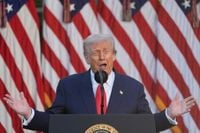On October 14, 2025, the White House Rose Garden became the stage for a moment that would ignite both admiration and controversy across the nation. President Donald Trump, now 79 years old, posthumously awarded the Presidential Medal of Freedom—the highest civilian honor in the United States—to Charlie Kirk, the conservative activist and founder of Turning Point USA. The ceremony, held on what would have been Kirk’s 32nd birthday, drew emotional tributes, partisan debates, and, unexpectedly, a flurry of social media chatter about the president’s new hair color.
Charlie Kirk’s story had taken a tragic turn just a month prior, when he was fatally shot while addressing students at Utah Valley University. His death on September 10, 2025, rocked the conservative movement and quickly became a flashpoint in America’s ongoing information wars. According to AP News and Reuters, Kirk’s activism had fused electoral politics with culture-war Christianity, creating a powerful youth-driven conservative apparatus that left a lasting mark on college campuses and beyond.
The White House framed the award as recognition of a "fearless advocate for liberty," and supporters hailed Kirk as a martyr for truth and freedom. During the ceremony, President Trump eulogized the late activist, declaring, "Charlie Kirk was a martyr for truth and for freedom. And from Socrates to Saint Peter, from Abraham Lincoln to Martin Luther King, those who change history the most, and he really did, have always risked their lives for causes they were put on Earth to defend." The president went on, saying Kirk was "looking down on them all from heaven, next to some of the most respected figures in history."
Kirk’s widow, Erika Kirk, accepted the medal on his behalf, delivering an emotional speech before an audience that included Kirk’s parents, Kathryn and Robert Kirk, family, and dignitaries. "If the moment had come, he probably would have run for president, but not out of ambition. He would only have done it if that was something that he believed that his country needed from a servant’s-heart standpoint," she shared, expressing gratitude to President Trump for honoring her late husband. The day was officially designated a National Day of Remembrance for Kirk, amplifying the significance of the occasion.
Yet, amid the solemnity, the ceremony sparked an entirely different kind of buzz online. Viewers tuning in noticed that President Trump’s hair, long the subject of public fascination, appeared unusually bright gray—a stark departure from its familiar orange hue. Social media platforms, especially X (formerly Twitter), lit up with comments and questions: "What color does Trump’s hair look like?" one user tweeted. Another wondered, "Is Trump’s hair super gray right now? Did he forget to color it?" Others speculated about possible dye jobs, with one remarking, "Did Trump dye his hair purple this week?" and another quipping, "Trump's hair is white now, can't call him orange man." Some critics were less charitable: "Look at Trump’s hair. It looks like old straw."
The hair debate wasn’t the only image-related controversy surrounding President Trump that week. On the same day as the ceremony, he took to Truth Social to lambast the cover photo of TIME magazine’s latest issue. The magazine had just released an edition following the dramatic release of 20 Israeli hostages—more than two years after the Hamas attack on October 7, 2023—an event that dominated international headlines. Trump, however, was unimpressed with the cover’s low-angle shot, complaining, "Time Magazine wrote a relatively good story about me, but the picture may be the Worst of All Time. They 'disappeared' my hair, and then had something floating on top of my head that looked like a floating crown, but an extremely small one." He called the cover "Really weird!" and further criticized the angle and lighting for making his hair appear thin.
Back at the White House, the posthumous award for Kirk quickly became a talking point not just for its symbolism but for what it revealed about the evolving legacy of the Presidential Medal of Freedom. As noted by The Guardian and other outlets, the medal has historically celebrated individuals whose broad, enduring contributions—often spanning decades—transcend partisan lines. Recent honorees under President Biden, for instance, included Hillary Clinton, George Soros, and Denzel Washington, all figures whose influence stretches across generations and fields as diverse as public service, civil rights, and the arts.
Kirk’s selection, by contrast, was seen by many as a departure from tradition. His rise was rapid, his influence explicitly partisan, and his career, though impactful, was largely confined to the past decade. Critics argued that the timing—coming barely a month after his death—heightened the sense that the award was being wielded as a political tool rather than a marker of enduring national gratitude. As The Guardian observed, "Honoring him so quickly after his death—barely a month—heightens the sense that the award is being used as an instrument of immediate politics rather than reflective gratitude."
Still, the White House’s decision underscored the flexibility of the award. The legal framework allows the president to select "any person" for the honor, with no statutory checklist or independent commission required. As Congress.gov notes, rapid, posthumous awards have occurred before, and speed is a political variable, not a procedural violation.
The reaction from Kirk’s supporters was swift and celebratory. Erika Kirk’s subsequent appearance at Turning Point USA, where she displayed the medal to staff, was captured in a video posted by Fon News on October 17, 2025. Addressing the team, she said, "I want you guys all to see the Medal of Freedom and be able to look at it in the back of it because... you guys are all part of the legacy. It's the first and last time I'll put a cross on it. I literally will stand here so all of you can see it... I don't care. Everyone can have their moment and see." The video quickly went viral, with over 120,000 views and 2,500 likes, reflecting both the emotional weight and the polarizing nature of the honor.
For some, the medal served as a recruitment poster for the conservative movement—a symbol that organizational hustle, media reach, and loyalty are now recognized at the highest levels. For others, it was a sign of "medal inflation," as the boundaries of the award’s meaning stretched to accommodate more immediate political narratives. As one analysis put it, "The Medal of Freedom is a stage the president controls; it’s a script he doesn’t need Stockholm or Oslo to approve."
In the end, the story of Charlie Kirk’s posthumous Medal of Freedom—set against a backdrop of presidential image battles and viral moments—offers a snapshot of a country grappling with the meaning of honor, legacy, and leadership. What we choose to see in that reflection may shape the medal’s resonance for years to come.


